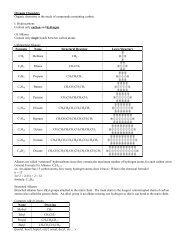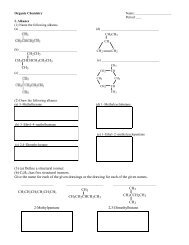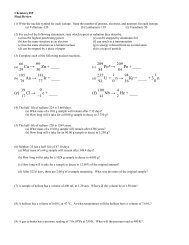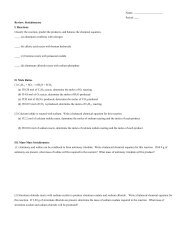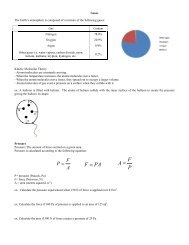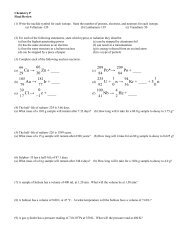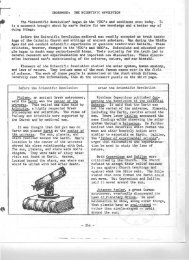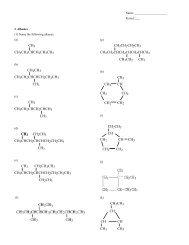disagreed with the established religious orthodoxy could be kicked out – ex. Roger Williams,who founded Providence, Rhode Island (1637) b/c he was exiled for promoting separation ofchurch and state, and Anne Hutchinson. Land distribution – In the Chesapeake, land was unevenly distributed. In New England,however, a few people would apply together for grants of land and would then plan villages inwhich everyone would get land. So, New England was much more egalitarian in that respect. Plantations vs. small towns – While the Chesapeake was <strong>com</strong>posed of sprawling plantationsNew England mainly consisted of small towns. Family life – In the Chesapeake, the predominance of males, the high mortality rate, and theincidence of servitude led to few, small, short-lived families. In New England, by contrast,people moved to the colonies already in family units and there was consequently a more evenmale: female ratio, which led to numerous, large [it was healthier there] and longer-lived [theycreated grandparents] families. Parents had far more impact on their children’s lives, as theyactually lived to see them grow up.- Clearly, the two regions developed very contrasting lifestyles over the years.<strong>Am</strong>erican Societies Take Shape (1640 – 1720)*The Restoration Colonies*- In 1642 the English Parliament, led by Oliver Cromwell, rebelled against Charles I [the absolutist monarchwannabe]. They finally won in 1646, and Charles was subsequently executed; Cromwell assumed control ofthe gov’t until his death in 1660. After the bad experience w/Cromwell [the Interregnum] the English decidedto restore the monarchy, so Charles II arrived [The Restoration].- All the events back in England had major consequences for the colonies. For one, since Puritans controlledthe gov’t from the War until the Restoration, their migration to New England slowed down a lot. Additionally,after 1660 six new colonies were formed [The Restoration Colonies] but this time as proprietorships.- The founding of the restoration colonies is as follows… New York was originally a Dutch colony, but in 1664 Charles II gave the area to his brotherJames, the Duke of York [pretending the Dutch weren’t there, I guess]. So James organized aninvasion fleet, and the Dutch surrendered w/o resistance [the merchants thought it would bebad for business]. In 1672 the Dutch briefly retook the colony, but in 1674 they permanentlyceded it as a result of their loss. New York was a very diverse colony and had a relatively high% of slaves as well, so the Duke was careful as he moved to establish his authority. Forinstance, in 1665 he passed The Duke’s Laws [first applied only to English settlements onLong Island and then later to the whole area], which maintained Dutch forms of local gov’t and(!) allowed religious toleration [each town could pick which church to support]. But it took until1683 for an elected legislature to be formed. So basically, until the 18th century New Yorkremained a relatively depopulated colony [grew slowly] w/few changes from Dutch rule. New Jersey was formed b/c the Duke of York regranted part of his land in 1664 to his friendsSir George Carteret and John Lord Berkeley [this actually deprived N.Y. of much neededfertile land and was one of the reasons the colony grew so slowly]. New Jersey, however,partially b/c its owners used land grants, limited toleration and the promise of an assembly toattract colonists, grew rapidly. W/in 20 years Carteret and Berkeley sold their sections toinvestors. All of Carteret’s part and some of Berkeley’s went to the Quakers, who wereseeking to escape persecution. Pennsylvania itself was actually founded by Quakers when in 1681 Charles II gave the regionto his friend William Penn, who then held it as a personal proprietorship. Penn used his colonyas a haven for fellow Quakers [who were radical egalitarians and denied the need for clergy]but also promised toleration, guaranteed English liberties to all, and established an assembly.<strong>His</strong> publicity efforts caused massive migration to the area. Some of the migrants were evenNative <strong>Am</strong>ericans, b/c Penn promised to treat them fairly as well. But his toleration was adouble-edged sword for the Indians, as many of the people he allowed in were not respectfulof them [the Scots, Irish, Germans and Swiss clashed w/them over land]. Carolina was granted by Charles II in 1663 in a lucrative semitropical area [could producemany valuable <strong>com</strong>modities]. The proprietors had John Locke draft the “FundamentalConstitutions of Carolina” for them, which (!) laid out a semi-feudal hierarchical society [it reallywas Locke, not kidding here]. Still, Carolina ended up splitting into two separate centers, whichsplit into separate colonies in 1729. Virginia planters settled North Carolina, establishing asociety very similar to their own; wealthy planters from Barbados settled South Carolina, and,after a few difficult years in which they depended on trade w/the Indians, began using largeamounts of slaves to cultivate rice and indigo.4
- So the Restoration Colonies, formed after Charles II was crowned in 1660, varied in <strong>com</strong>position but wereall basically proprietorships.*Problems Faced by the Existing Colonies in the 1670s and 1680s*- In the 1670s and 80s, the original French, Spanish and English colonies faced numerous crises, mainlycaused by their relationships w/the Native <strong>Am</strong>ericans in their respective areas.- For instance, in New France, the governor decided to expand into the south and west in the 1670s[wanted to gain direct control over the fur trade]. This brought them into conflict w/the IroquoisConfederacy, which had had skirmished w/the Europeans over the fur trade [the Beaver Wars] as early as1633. So in the 1670s, the French began attacking Iroquois villages and in 1701 a neutrality treaty wasnegotiated by the exhausted Confederacy. The French also expanded by settling up outposts in theMississippi region, where travelers and traders could stop between Quebec and Louisiana.- New Mexico also experienced significant problems. B/c the Franciscans had been increasingly harsh onthe subjugated Pueblo peoples in efforts to try to totally erase their native religion and culture [also colonistsdemanded heavy labor tributes] the natives rebelled in 1680 under Popé. Although Spain regained control in1692 the governors changed tactics and became more cooperative. Spain also expanded their territory byestablishing military outposts and missions to the east and north.- In the English colonies [both New England and the Chesapeake], however, problems didn’t start b/c oftrade [New France] or religion [New Mexico] but simply b/c of land issues.*New England – King Phillip’s War*- In New England, the expanding population resulted mainly from natural increase, rather than fromimmigration, which slowed down greatly after the outbreak of the Civil War in 1642. But b/c of the goodconditions and large families, the population had tripled by the 1670s through natural increase alone.- The increase created a need for land, and settlement began to spread farther into Massachusetts andConnecticut, and even north to New Hampshire and Maine. Other families gave up on agriculture altogetherand took up skills like blacksmithing or carpentry.- Nevertheless, settlements gradually came to surround the lands of the Pokanokets, whose chief, KingPhillip, was the son of Massasoit [wel<strong>com</strong>ed the Pilgrims]. Concerned by the loss of land and the impact ofChristianity, King Phillip began attacking settlements in June 1675. Other Algonquians joined, and even themore well established villages began to face attacks in 1676 [Plymouth and Providence].- But the tide turned in the summer of 1676, when the Indians began to lack supplies and the colonistsbegan using Christian Indians as guides. After the Mohawks [enemies of the Algonquians] helped byattacking a major Wampanoag camp on June 12 and King Phillip died in August, the colonists emergedvictorious and started selling the captured Indians into slavery. The power of the coastal tribes was broken.- It’s important to note that the victory came w/a cost – 1/10th of the male population was killed or wounded,towns were devastated, and the economy didn’t reach pre-1675 levels until the <strong>Am</strong>erican Revolution.*The Chesapeake – Bacon’s Rebellion*- Around the same time, Virginians also experienced conflict w/the Indians b/c of land, although the conflictplayed out slightly differently. After land-hungry Virginians attacked two Indians tribes, Indians raidedoutlying farms in retaliation in the winter of 1676.- Governor William Berkeley, however, was reluctant to strike back b/c: (1) he had trade agreements w/theIndians and didn’t want to disrupt them and (2) he already had land and didn’t want <strong>com</strong>petition anyway.- So the angry colonists [many former indentured servants] rallied around recent immigrant NathanielBacon, who held members of the House of Burgesses until they authorized him to attack the Indians andwas consequently declared to be in rebellion by Berkeley.- Throughout the summer of 1676, then, Bacon fought both Indians and supporters of the gov’t, evenburning Jamestown itself to the ground. Even though the rebellion died w/Bacon in October, the point wasmade and a new treaty in 1677 allowed more territory to be settled.- Besides being a turning point in relations w/the Indians, Bacon’s rebellion had another very importantconsequence. As landowners realized that there wasn’t much land left to give to indentured servants, thecustom stopped and they began looking for slave labor instead.*The Introduction of African Slavery*- As a consequence of Bacon’s rebellion and the reluctance of indentured servants to go to the Chesapeake[no more land] planters turned to slavery as a labor source.5
- Page 3: Congregationalists (Puritans) - The
- Page 7 and 8: - So in England, where they were lo
- Page 9 and 10: *Colonial Politics 1700-1750: Relat
- Page 11 and 12: - Another ideology that was beginni
- Page 13 and 14: - The Quebec Acts were passed aroun
- Page 15 and 16: - So, by 1782, what had seemed to b
- Page 17 and 18: on the economic side, since the gov
- Page 19 and 20: - Anyway, Congress had several ques
- Page 21 and 22: - Adams was still in the early Wash
- Page 23 and 24: *Political Factionalism and Jeffers
- Page 25 and 26: - Samuel Slater set up the first te
- Page 27 and 28: - Court rulings extended the powers
- Page 29 and 30: Revival, Reform and Politics during
- Page 31 and 32: - Anyhow, during his administration
- Page 33 and 34: TEXAS (Southerners) - Texas had bee
- Page 35 and 36: - Anyhow, Pierce’s total support
- Page 37 and 38: They had a smaller everything: smal
- Page 39 and 40: - The two Northern victories at the
- Page 41 and 42: - The result was the Fourteenth Ame
- Page 43 and 44: The Slaughter-House Cases (1873) -
- Page 45 and 46: in the arrest of 8 immigrant radica
- Page 47 and 48: case (1897 - ICC can’t set rates)
- Page 49 and 50: - The Populists prepared to run aga
- Page 51 and 52: - MOST IMPORTANTLY, though, was the
- Page 53 and 54: - So, what led the US to undertake
- Page 55 and 56:
- The rebellion, led by Emilio Agui
- Page 57 and 58:
- Still, Americans managed to turn
- Page 59 and 60:
- So - the point of this episode? B
- Page 62 and 63:
*Hoover’s Response*- Poor Herbert
- Page 64 and 65:
- In FDR’s second term, however,
- Page 66 and 67:
Dominican Republic - When we left i
- Page 68 and 69:
World War II (1941 - 1945)*The Cour
- Page 70 and 71:
- So Truman started off again all c
- Page 72 and 73:
- First of all, the 1950s were (for
- Page 74 and 75:
peace w/Japan that ended occupation
- Page 76:
- France wanted out, so at the Gene



